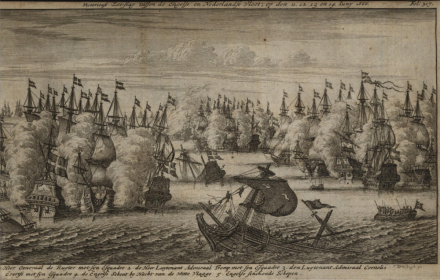History
The Liefde was a ship of the line of the Amsterdam Admiralty. It was built in 1661 and saw action during the second Anglo-Dutch War (1664-1667).
Battle of Lowestoft
The Liefde first took part in a fight during the Battle of Lowestoft on June 13th, 1665. This naval battle went very badly for the Dutch fleet. Chaos arose when commander Van Wassenaar Obdam died and his ship the Eendracht exploded because of a shot to the powder room. The Liefde performed better - it helped to heavily damage the English yacht Charity. The Charity was a formerly Dutch ship, coincidentally also called the Liefde, which had been taken by the English in the Battle of Portland in 1653 during the first Anglo-Dutch War.
Four Days' Battle
A year later, another large naval battle was fought. The Dutch fleet under admiral Michiel de Ruiter had 82 ships and a number of fire ships. The English fleet under Monk had 65 ships and 10 fire ships. The Liefde served in the squadron of the Amsterdam Admiralty under admiral Cornelis Tromp.
On the second day of the battle, four ships of Tromp's squadron were separated from the main force. It concerned the ships Hollandia (under Tromp), Liefde (Salomonsz), Blauwe Reiger (Adriaansz) and Callantsoog (De Haan). The attacked the admiral's ship of general Monck. The English fleet in the mean time had positioned itself between de Ruiter and Tromp. Because of this, the four ships got into a tight spot. De Ruiter managed to break through the English fleet and relieve Tromp. This was too late for the Liefde:
The ship the Liefde, captained by Pieter Salomonszoon, was set ablaze by an English fire ship when General de Ruiter came to relieve them with his squadron, so that one was hardly able to salvage the captain and a part of his crew (translated from Brandt, p. 485).

Eye witness
The Danish soldier Hans Svedsen served on the ship the Blauwe Reiger. This ship took part in the fighting and because of this, he could report a number of details on the demise of the Liefde:
After Tromp had been fighting for two hours, both his foremast and main mast got overboard. One of our own ships, the Liefde (Captain Pieter Salomonsz.), was the cause of this. While the Liefde and the Hollandia had gotten so close together and the Liefde got into such a strong current that it drifted onto Tromp; captain Pieter Salomonsz. was the cause of this himself, for he did not lessen sail. At the same moment that these two ships lay board to board, the English vice admiral Berkeley, flying the white flag on the top of the fore mast, came and gave the Liefde and the Hollandia a full broadside on port; the two ships could not answer the fire because of one another.
My captain, Hendrik Adriaensz., seeing this, set sail to aid Tromp; when we were at Tromp we struck sails and would have helped him; but Tromp took off his hat to my captain and said, keep this man way from me; upon this we dropped our foresail and went after Berkeley.
When we were standing off of Tromp, two English fire ships went towards Tromp, who had gotten loose from the Liefde after his masts were cast overboard; one of the English fire ships reached the Liefde and set her on fire.
Description
Yard: Amsterdam (Admiralty Yard?)
Armament: 66 cannon
Crew: 275 sailors, 45 soldiers
| Master | Pieter Salomonsz. |
|---|---|
| People on board | 320 |